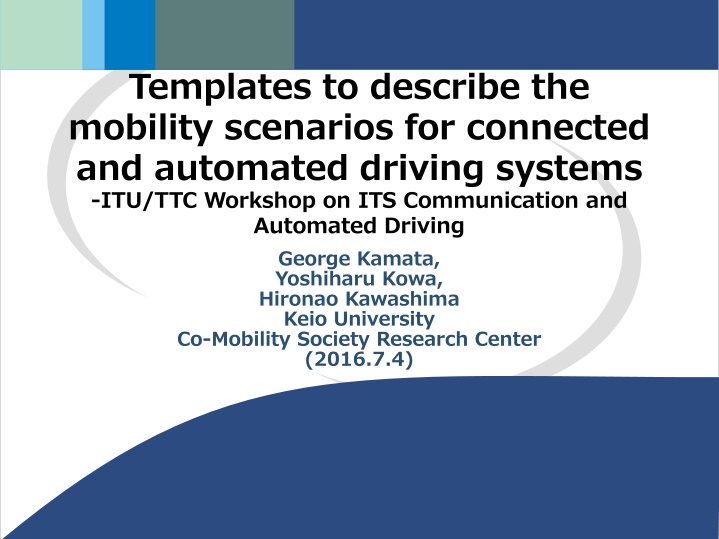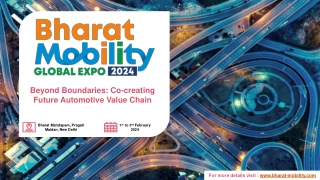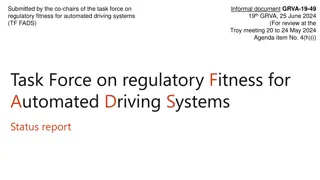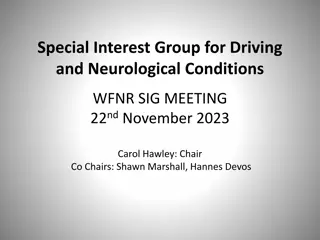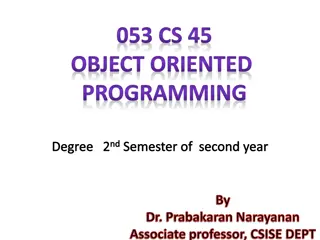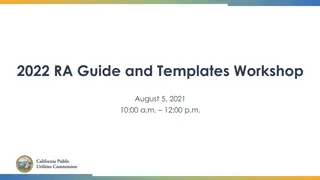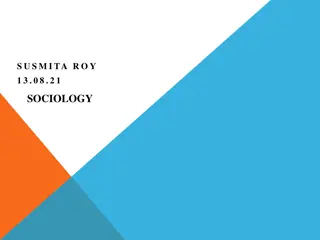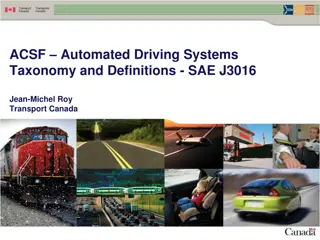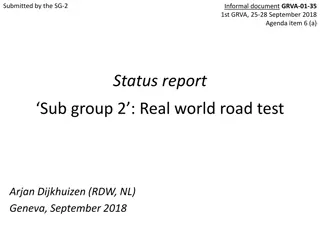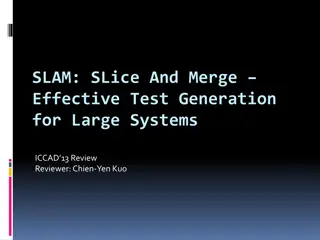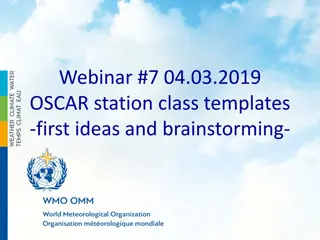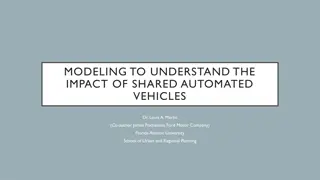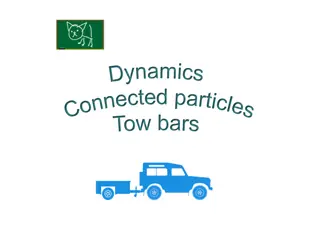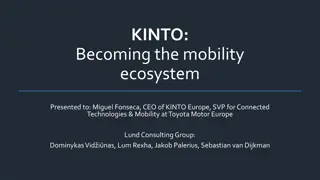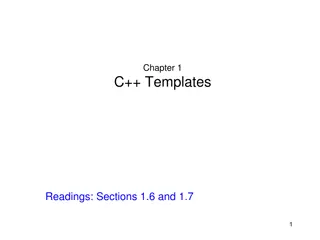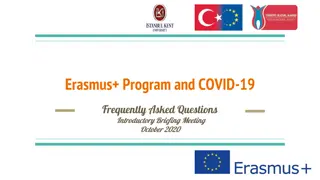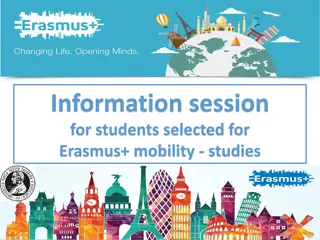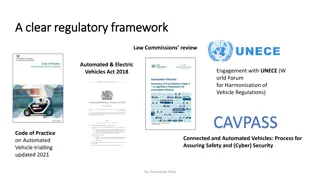Templates for Mobility Scenarios in Connected & Automated Driving Systems
This report introduces templates for describing mobility scenarios in the context of connected and automated driving systems. It explores the importance of mobility, communication systems for vehicles, and examples of traffic management in mixed conditions, emphasizing the role of ICT. The visuals and concepts presented shed light on the future of transportation technology.
Download Presentation

Please find below an Image/Link to download the presentation.
The content on the website is provided AS IS for your information and personal use only. It may not be sold, licensed, or shared on other websites without obtaining consent from the author.If you encounter any issues during the download, it is possible that the publisher has removed the file from their server.
You are allowed to download the files provided on this website for personal or commercial use, subject to the condition that they are used lawfully. All files are the property of their respective owners.
The content on the website is provided AS IS for your information and personal use only. It may not be sold, licensed, or shared on other websites without obtaining consent from the author.
E N D
Presentation Transcript
Templates to describe the mobility scenarios for connected and automated driving systems -ITU/TTC Workshop on ITS Communication and Automated Driving George Kamata, Yoshiharu Kowa, Hironao Kawashima Keio University Co-Mobility Society Research Center (2016.7.4)
Contents 1. Introduction 2. A new approach 3. Hypothetical examples of the mobility scenarios using the templates 4. Concluding remarks 1
1. Introduction This report is an attempt to propose templates for describing the mobility scenarios when connected and automated driving systems are introduced. 2
Mobility Mobility is a task which starts from point A to point B to accomplish certain purpose such as to travel for commuting, shopping, sightseeing etc, and transport of goods. 3
Communication for the vehicle moving from A to B ITS communication systems such as V2V, I2V are developed for the mobility assuming the use of map database and various on board sensors. Wide area traffic conditions and weather conditions are transmitted by other communication systems such as cellular phone system. The systems to monitor goods movements and the remote management of L2, L3, L4 automated vehicles also require specific communication systems. 4
Example of new traffic management when CACC and Automated Driving in mixed traffic conditions ICT for Macroscopic Monitoring at the main lane Vehicle group 1 Vehicle group 2 V2V V2V V2V V2V V2V V2I V2I V2I V2I Cellular base station Cellular base station Traffic management center with connected vehicle capabilities without connected vehicle capabilities (Source: Keio University, Co-Mobility Society Research Center, Amsterdam Group and MLIT meeting, Oct 2015) 5
ICT for Microscopic Management at flat lane rampway V2V V2V V2I RSE V2I I2I Visual contact VMS Traffic management center with connected vehicle capabilities without connected vehicle capabilities Cellular base station (Source: Keio University, Co-Mobility Society Research Center, Amsterdam Group and MLIT meeting, Oct 2015) 6
ICT for Microscopic Management at a rampway with elevated lane V2I V2V V2V RSE V2V unavailable due to obstruction I2I Visual contact VMS Ground level road V2I Traffic management center Cellular base station with connected vehicle capabilities without connected vehicle capabilities 7 (Source: Keio University, Co-Mobility Society Research Center, Amsterdam Group and MLIT meeting, Oct 2015)
Communication and Mobility In order to accomplish the purpose of mobility, the additional tasks and managements using suitable communication systems are required. To check in the hotel To obtain a ticket for a train after using the shuttle Fare adjustment for passengers Inventory management at the freight depot Traffic management in the mixed traffic conditions by using various communication systems MaaS (Mobility as a Service) 8
2. A new approach The Background Integrated model or method to describe the whole chain of information flow related to mobility, seems to be missing when introducing automated driving systems. Famous the five or six levels of Vehicle Automation model does not handle information exchange between vehicle and outside environment using communication systems. Since the model is purely vehicle oriented, there is a need to extend the model which can clearly describe the requirements from the information and communication technologies. 9
Summary of Levels of Driving Automation for On-Road Vehicles 10
(1)The first template A template which can describe the whole information needs in conjunction with the accomplishment of the mobility task, namely departing from A and arriving at B. (2)The second template The Vehicle Automation Model is extended to include the functions related to driving management. The function sharing by vehicle, human and management is depicted in an abstract way. Moreover, during the travel from A to B, Vehicle Automation Level might transit due to the complexity of traffic, for example. Therefore, 5 level model is extended to depict an abstract trajectory of the level transition during the travel. The definition of the function sharing and the trajectory are still ambiguous but the definitions depend on the systems and use cases and further study is left to the future efforts. 11
Templates of Mobility Models Vehicle Origin Destination A B Operating functions Further demand for mobility Emergency Primary demand for mobility Probe system Management Center (SMC) R Management Level Profiles Traffic Management Center Regulation issues Security, Privacy issues HMI Stakeholders Business model Expected market demands Regulations Other Sources of information, data 12
An extension of Vehicle Automation Model Templates to describe the relationship between the functions of the Vehicle Automated Level and traffic complexity Function sharing Hard V Vehicle Function Systems to move the vehicle smoothly such as the controller of steering, braking and acceleration; and to recognize the surrounding environment of the vehicle by using onboard sensors. M H L4 V Vehicle Automation Level Development M Management Function M V L3 Systems to support the vehicle function such as providing traffic information using TPEG, VICS; route guidance by car navigation system; management of the remaining battery life of EV; dispatching and routing for physical distribution system Medium H M L2 V H H HumanFunction M The decision made by human to accomplish the mobility tasks which include decisions made by drivers and the operator of the monitoring system of vehicles in the traffic V L1 H Traffic complexity M L0 V H The traffic governed by very large volume of vehicles and number of regulations Heavy Easy Communication network Hard Medium The traffic with moderate volume of vehicles which will not be the cause of heavy congestion such as the traffic in motor ways, highways and the traffic in rural areas Drivingfunction Drivingmanagement Scarce The traffic with very small volume of vehicles and simple regulations such as the traffic in sparsely populated area. Also in the case when heavy traffic congestion occurs at highways See also the article by Brad Templeton A critique of NHTSA and SAE Levels of self-driving at http://www.templetons.com/brad/robocars/levels.html
3. Hypothetical examples of the mobility scenarios using the templates Automated driving on highways Truck platooning Robo-taxi in urban area Shuttle bus in dedicated region Vehicle Automation: Myth vs. Reality by Bob Denaro Automated driving will have something everywhere and everything some where, but not for long time everything everywhere (Source: ITS international March/April 2016) 14
(1) Automated Driving on Highways Vehicle Automated Driving by on board sensors Change to driver s mode Route and mode selecting by using traffic info. From HTMC - A B - - Destination Ramp When to start automated mode - - End of automated driving Prob Emergency Management Level Special management at intersections and ramps Highway Traffic Management Center (HTMC) - Traffic condition of mixed traffic - Weather, incidents, accidents info. Regulations Inform general users about mixed traffic situation 15
(2) Platooning of heavy trucks on highways Depot adjacent to highway Vehicle Automated driving by on- board sensors Change of driving mode A - B - Goods documents to unbundle goods Emergency Probe Goods documents to bundle goods Weight balance among the vehicles Anticipated road works - System Management Center - Locations, speed of platooning vehicles - Priority of platooning vehicles - Weather, incidents, accidents info. - - Warehouse management information system Warehouse management information system HighwayTraffic Management Center Monitoring of platooning vehicles Infrastructure to support the movements of the platooning vehicles and the depot management Infrastructure to support the movements of the platooning vehicles and the depot management - Management Level - A driver at the forefront - Special management at intersections and ramps Use I2V, VMS to provide information about platooning vehicles Traffic flow management issues at on-ramp locations. Integrated utilization of I2V, V2V communications are required. 16 Regulations
(1) Automated Driving on Highways (2) Platooning of heavy trucks on highways Function sharing Hard M H L4 V (1),(2) Vehicle Automation Level Development M V L3 H M L2 V H M V L1 H M L0 V H Easy Communication network Hard Drivingfunction Drivingmanagement V Vehicle Function M Management Function H Human Function
(3) Automated Driving by Micro Vehicle in a sparsely populated area Vehicle Automated driving using on- board systems A B Automated Parking Guide Emergency Probe Reservation of the hospital, for example Micro Vehicle Monitoring Center - Locations, map - Weather, incidents - Area restriction Management Level Less than 30Km/h in restricted region In winter time, a special vehicle is required for the use on snow- covered roads. Regulations 18
(4) Automated Driving for Park and Ride Final Destination Vehicle Home Station Automated driving by on-board sensors and traffic info.. From MC A B C Time table of train, metro and bus Reservation of the ticket Reservation of final destination - Travel schedule Emergency Probe - Monitoring Center (MC) - Locations, Map data - Signal info. - Blind corner info. - Pedestrian, bicycle info. - Route selection - Management Level Less than 10Km/h in the parking area Traffic Management Center Travel Information Center Improvement of road infrastructure and surrounding environment to obtain clear machine visibility Regulations Provide local and real time information of mixed traffic by using I2V, V2V ITS communications 19
(3) Automated Driving by Micro Vehicle in a sparsely populated area (4) Automated Driving for Park and Ride Function sharing Hard M H L4 V Vehicle Automation Level Development (3) M V L3 H Medium M L2 V H M (4) V L1 H M L0 V H Easy Communication network Hard Drivingfunction Drivingmanagement V Vehicle Function M Management Function H Human Function
(5) Automated Vehicle (TaxiBots and AutoVots) in urban area Drop off Point Vehicle Pick up Point Automated driving by on-board sensors and traffic inf. From MC A B Input destination - Exact location (which side of the road) - Time schedule of metro and/or bus Emergency Probe Monitoring Center - Locations, Map data - Signal info. - Blind curve info. - Pedestrian, bicycle info. - Route selection - Route strategy to respond to the new users Other request Management Level - Regional constraints - Time constraints - Multiple vehicle monitoring and management Improvement of road infrastructure and surrounding environment to obtain clear machine visibility Traffic Management Center Provide local and real time information of mixed traffic, especially at intersections by using I2V, V2V ITS communications TaxiBot: Self driving cars that can be shared simultaneously by several passengers AutoVot: Pick-up and drop-off passengers sequentially Regulations 21
(6) Automated (shuttle) bus in urban area Vehicle Automated driving by on- board sensors and traffic inf. from MC Pick up Point Drop off Point A B Emergency Probe Passenger management Fare management - - Monitoring Center - Locations, map data - Time schedule - Signal info. - Blind corner info. - Pedestrian, bicycle info. Traffic Management Center Improvement of road infrastructure and surrounding environment to obtain clear machine visibility Management Level - Zone constraints - Time constraints Provide local and real tie information of mixed traffic along the bus route by using I2V, V2V ITS communications Wi-Fi service in the bus Business model; No driver but a courier on board Regulations 22
(5) Automated Vehicle (TaxiBots and AutoVots) in urban area (6) Automated (Shuttle) bus in urban area Function sharing Hard M H L4 V (5) (6) Vehicle Automation Level Development M V L3 H Medium M L2 V H M V L1 H M L0 V H Easy Communication network Hard Drivingfunction Drivingmanagement V Vehicle Function M Management Function H Human Function
(7) Automated shuttle bus in restricted area Vehicle Pick up Point Drop off Point A Automated driving using on-board sensors B Emergency Probe - Passenger management - Fare management Monitoring Center - Locations, map - Pedestrian, bicycle info. - Time schedule Management Level Less than 30Km/h Regulations Wi-Fi service in the shuttle Business model No driver but a courier on board - Multiple vehicle management by the monitoring center 24
(8) Automated delivery vehicle in a sparsely populated area Vehicle Origin Destination Automated driving by on- board sensors A B Shopping list from customers Delivery completed Invoice and payment Emergency Probe System Management Center - Locations, map - Weather, incidents - Area restriction - Route selection for additional order Additional order from other customers Management Level Less than 30Km/h in restricted region Regulations 25
(7) Automated Shuttle bus in restricted area (8) Automated delivery vehicle in a sparsely populated area Function sharing Hard M H L4 V (7) (8) Vehicle Automation Level Development M V L3 H Medium M L2 V H M V L1 H M L0 V H Easy Communication network Hard Drivingfunction Drivingmanagement V Vehicle Function M Management Function H Human Function
4. Concluding remarks Benefit of using the template 1. The whole information needs in conjunction with the mobility can be described. 2. The transitions of driving supports (e.g. L3 to L2) in conjunction with the behavior of surrounding traffic and transport environment, can be described. 3. The gap between existing technology and standards and developing technology in terms of interoperability can be easily extracted. 27
